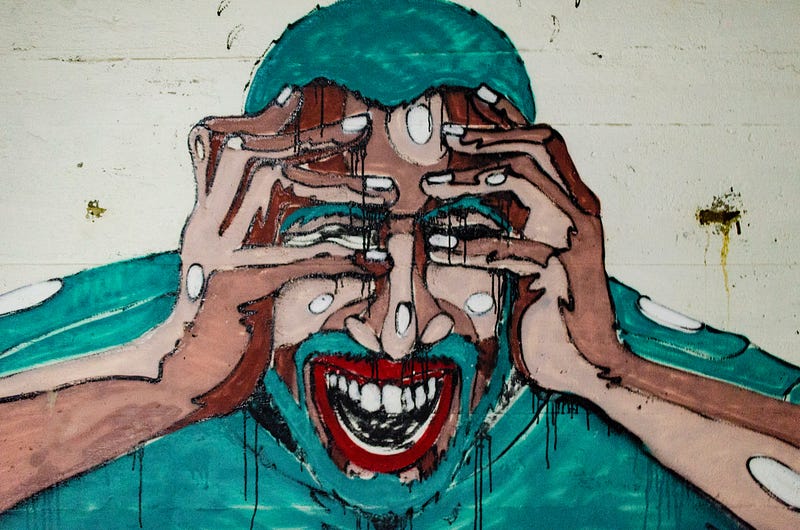Saturday. Steve and I are doing yoga at home with our teacher, Nadine. Something’s clicked! Today I’m not trying so hard to not-try-so-hard to nail the poses. Sometimes, I feel like a stitched-together jumble of muscles and bones. But today, I’m in harmony. For months, Nadine’s been showing how subtly tilting the pelvis frees the spine so that body extends naturally, finding repose on the anchor of the legs. Yes! I feel it. I feel powerful.
What a great class. At the end, Steve and I lie in corpse pose while Nadine leads a short meditation. Corpse pose involves a complete letting go. We allow our resting bodies to fully melt into the floor. Well, ideally we do.
Nadine speaks gently: “This philosophy says that tension in the body comes from resisting our experience.” I’m still relaxed(ish), but my mind throws out a silent comeback: “You’re goddamn right it does. And for good reason!” I remain lying on my back, and I’m still (sort of) melting, but an old feeling creeps over me: Someone might grab me. I might be attacked.For the rest of the meditation, I tune out what Nadine is saying. I remind myself I’m safe — NOW. I do feel safe here. I trust Nadine. I wouldn’t be living in this house if I didn’t trust Steve.
Bowing to one another, yoga’s over for today. I describe what just happened, and they understand. Those two states of being — flow and fear — have rarely followed one another so quickly. I’m glad it’s happened, I tell them. This is what my life’s made of, and I’ve learned that to keep healing, you have to feel ALL the feels.
When I first started practicing mindfulness meditation 10 years ago, none of the teachers I sat with promised quick happiness. But they also didn’t say that for people with a trauma history, meditation can throw you back into feeling the abuse is happening again — even in a safe situation. Most of the published writing on mindfulness is glowing and positive, and it should be. BUT.
Why can mindfulness be problematic? A chattering mind serves as protection against old, unpleasant memories and feelings. It’s tempting to blame oneself for not being “good at” mindfulness, but survival skills don’t discriminate. We developed those for good reason! Any change in habitual behavior — like sitting still when running around has always felt safer — can trigger whatever the activity was intended to repress. I learned through trial and error that long ago, my body and mind had developed a kind of noisy survival dance. Being in silence is always challenging, but it can be extra challenging for someone with a trauma history.
Mindfulness can be powerfully effective in the context of overall healing.
This confused me sometimes. I love silence. My body craves rest. There were indeed times when I experienced the magical, neurological calm that meditation promises. Yet fundamentally, mindfulness is about allowing yourself to see what IS. Part of what IS — of who I am — has to do with child, adolescent, and young adult trauma. Cause and effect was hard to trace. I never freaked out BECAUSE I was meditating, or even during meditation — although this can happen, and people who teach meditation should be prepared to help folks deal with it. Sometimes I experienced a delayed reaction that didn’t feel connected to anything. Opening up to joy means opening to the old fears that block joy — and, as long as inner resources and outward supports allow old feelings to be processed and healed, that’s not a problem.

A few years ago, I stopped meditating. My life had changed, and I wasn’t attending group meditation, anyway. The hiatus afforded me the distance to understand why my meditation experience was a mixed bag. For one thing, seeing the practice is retrospect helped me see hidden motivations. I had tried to “use” meditation to fix what I perceived was “wrong” with me — a common trauma reaction. My commitment to the practice had partly to do with proving to my teachers that I meant business — that I was no spiritual butterfly, flitting from one feel-good technique to another. Having suffered a lot when I was growing up meant that I had a hard time accessing simple pleasures that others took for granted, and I sometimes judged people for enjoying meditation “too much.”
I’m heartened that the phrase trauma-informedhas entered the public consciousness. It serves as a guard against seeing mindfulness as a quick fix to complex problems. Some educators who promote mindfulness in schools are speaking caution about the fact that even closing one’s eyes feels dangerous to some children — along with offering guidelines about how to teach it safely. Currently, California’s Surgeon General is bringing attention to the fact that Adverse Childhood Experiences lead to poor health outcomes later in life. The point isn’t to make everyone so self-conscious about trauma triggers that we stop taking risks in helping others. The point is to bring the culture in line with reality. Techniques don’t heal people. But techniques, skillfully applied, can be powerful tools for healing. Trauma survivors are uniquely positioned to teach others what really works for them.
Trauma survivors can be great educators in every sphere of their lives, making the world a more healing place.
I am meditating again, by the way. It’s not always easy, but it’s good. I’ll bring any difficult experiences to work through with my therapist. Knowing that I can sometimes be triggered puts mindfulness in context, making it a lot less scary.
Relevant Links:
The California Surgeon General’s Mission to Address Childhood Trauma
Contact: hmallon@navpoint.com


Comments (1)